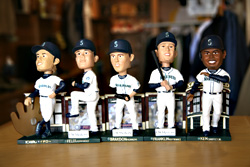This Friday, 20,000 fans will walk out of Safeco Field with nodding Ken Griffey Jr. figurines. Just where do these 7½-inch polyresin bobblehead dolls come from? The answer is China, but the design process goes down at an office in Woodinville.
Mike Corley’s job is to take a photo of the soon-to-be-bobbling athlete and transform his or her being into a cartoon-like sketch, keeping as many features intact as possible. What sets Corley apart from the street cartoonist is that his sketches are digitized, and he works for a company, Bensussen Deutsch & Associates (BDA), that is the #1 producer of bobbleheads for Major League Baseball.
The 25-year-old Art Institute of Seattle grad first scans a sketch onto his Mac, then colorizes it while perfecting small details most people would never notice, like what color glove a player wears or what foot he leads with when he slides into base. He then e-mails the sketch to the BDA office in southern China that works with manufacturers to hand-carve and paint the dolls. A proof is sent back, and Corley responds with simple phrases like “nose too big, make smaller” to help Chinese manufacturers with a rudimentary grasp of English improve the doll.
The process usually requires several revisions, says Corley. An unpainted sculpture of comedian Wanda Sykes’ doll (the phenomenon is not restricted to sports) resembles an ancient Greek statue with a sponge for hair. Sykes’ agents said this rough draft looked too manly and her hair wasn’t right. “Working with [manufacturers] overseas can be challenging,” Corley explains. “The people in the factory probably haven’t seen many Afros before, which is why it looked like a sponge.”
When he’s not digitally chiseling a baseball player’s arms for BDA’s next bobblehead, Corley designs sketches for guns used in video games, among other promotional gear. He was working at a video-game company when BDA scouted him four years ago, and has been there ever since. “I never thought I would be doing this,” Corley says.
Bobbleheads made their grand splash in Seattle in 2001, when the Mariners enjoyed their MLB record-tying 116-win season and introduced the first Ichiro Suzuki bobblehead. Fans camped out the night before to get in line for a miniature Ichiro. Afterward, they were sold online for $140 a pop.
The design of bobbleheads has improved since then, but for collectors the resale value has decreased, since dolls have flooded the market. “The overall quality and workmanship is better,” says Shane Schulke, owner of Shane’s Big League Sports Cards in Renton. “Before you just got a bobblehead on a base, and now the Mariners do a series of four to six players that fit together with backdrops.” He adds that this year’s Griffey giveaway won’t stir up the mania that Ichiro’s doll did eight seasons ago.
Steve Avanessian, Vice President of Sports for BDA at its corporate headquarters in Woodinville, says the company is very detail-focused when planning a doll, ticking off such questions as: “Do they have a three-day beard? Is there a particular way they wear their pants? Do they have a wedding ring, sweatband, or tuck in their pants?” Bobbleheads have gotten so huge nowadays, he says, players write bobblehead promotional nights into their contracts with clubs. “Once you’ve been done as a bobblehead, you’ve hit a new level,” he says.
The company made one major error in 2006, when Baltimore Oriole Brian Roberts’ bobbleheads mistakenly portrayed the Caucasian second baseman as African-American. Avanessian chalked that up as a “miscommunication,” and said that in the end fans got the appropriate bobbleheads—though they had to come back to the park with a voucher on a different day.





